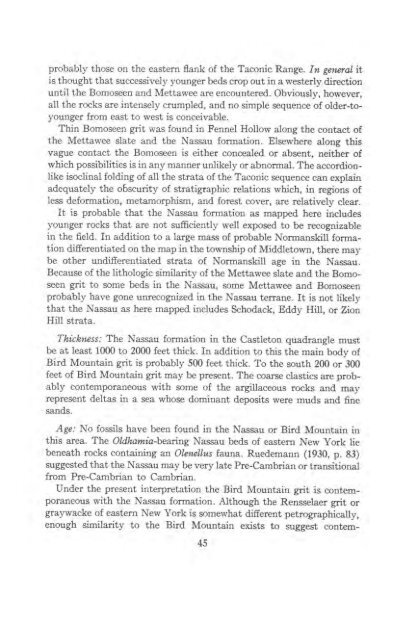STRATIGRAPHY AND STRUCTURE CASTLETON AREA VERMONT
STRATIGRAPHY AND STRUCTURE CASTLETON AREA VERMONT
STRATIGRAPHY AND STRUCTURE CASTLETON AREA VERMONT
You also want an ePaper? Increase the reach of your titles
YUMPU automatically turns print PDFs into web optimized ePapers that Google loves.
probably those on the eastern flank of the Taconic Range. in general it<br />
is thought that successively younger beds crop out in a westerly direction<br />
until the Bomoseen and Mettawee are encountered. Obviously, however,<br />
all the rocks are intensely crumpled, and no simple sequence of older-toyounger<br />
from east to west is conceivable.<br />
Thin Bomoseen grit was found in Fennel Hollow along the contact of<br />
the Mettawee slate and the Nassau formation. Elsewhere along this<br />
vague contact the Bomoseen is either concealed or absent, neither of<br />
which possibilities is in any manner unlikely or abnormal. The accordionlike<br />
isoclinal folding of all the strata of the Taconic sequence can explain<br />
adequately the obscurity of stratigraphic relations which, in regions of<br />
less deformation, metamorphism, and forest cover, are relatively clear.<br />
It is probable that the Nassau formation as mapped here includes<br />
younger rocks that are not sufficiently well exposed to be recognizable<br />
in the field. In addition to a large mass of probable Normanskill formation<br />
differentiated on the map in the township of Middletown, there may<br />
be other undifferentiated strata of Normanskill age in the Nassau.<br />
Because of the lithologic similarity of the Mettawee slate and the Bomoseen<br />
grit to some beds in the Nassau, some Mettawee and Bomoseen<br />
probably have gone unrecognized in the Nassau terrane. It is not likely<br />
that the Nassau as here mapped includes Schodack, Eddy Hill, or Zion<br />
Hill strata.<br />
Thickness: The Nassau formation in the Castleton quadrangle must<br />
be at least 1000 to 2000 feet thick. In addition to this the main body of<br />
Bird Mountain grit is probably 500 feet thick. To the south 200 or 300<br />
feet of Bird Mountain grit may be present. The coarse elastics are probably<br />
contemporaneous with some of the argillaceous rocks and may<br />
represent deltas in a sea whose dominant deposits were muds and fine<br />
sands.<br />
Age: No fossils have been found in the Nassau or Bird Mountain in<br />
this area. The Oldhamia-bearing Nassau beds of eastern New York lie<br />
beneath rocks containing an Olenellus fauna. Ruedemann (1930, p. 83)<br />
suggested that the Nassau may be very late Pre-Cambrian or transitional<br />
from Pre-Cambrian to Cambrian.<br />
Under the present interpretation the Bird Mountain grit is contemporaneous<br />
with the Nassau formation. Although the Rensselaer grit or<br />
graywacke of eastern New York is somewhat different petrographically,<br />
enough similarity to the Bird Mountain exists to suggest contem-<br />
45













